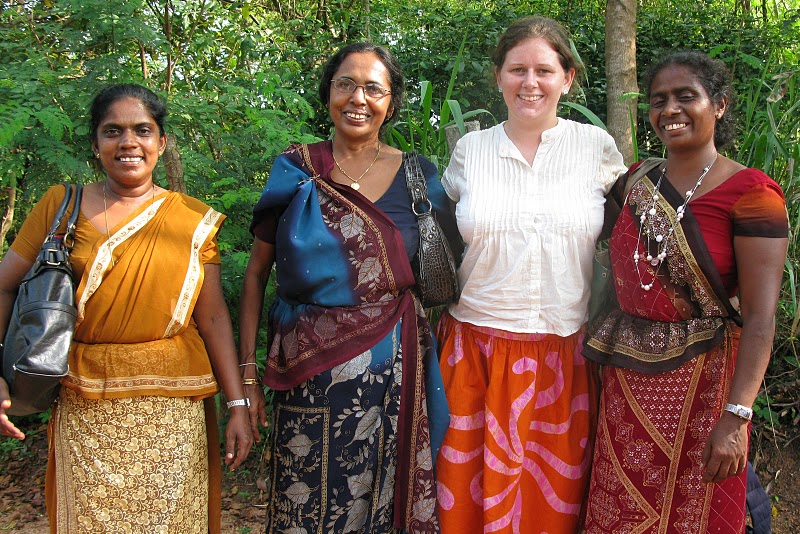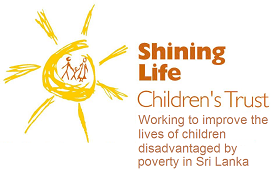The 6-month project
The 6-month project ran from March to August 2009.The objectives of the six-month project were:
- develop three active women’s societies and three active children’s clubs
- develop a 2-3 year main project proposal
- engage women’s societies and children’s clubs in developing 2-3 year project proposal
- equip women’s society leaders with skills in leadership and communication
- equip women’s societies with skills to manage savings and instant loans
- equip children’s clubs with sports equipment
- enable children’s clubs to celebrate Sinhala/Tamil New Year appropriately
- complete a baseline survey and data collection in all villages
- train mothers in early childhood care and development (ECCD)
- train women’s society members in health and nutrition
- train children’s clubs members in health and nutrition
- equip three preschools
- train mothers in weighing infants.

Human Development Foundation project staff and Jane
Slocombe (Field Director 2009-10)
The following activities were carried out:
- Women’s Society creation and training in leadership, management of savings, ECCD, infant weighing and health and nutrition
- creating and maintaining children’s clubs, with the following activities: New Year Festival, and the provision of sports equipment and preschool equipment
- project planning sessions
- baseline survey
Attendence at mother’s society meetings, children’s clubs and training sessions was monitored closely. The average participation was 26 people per training session, with the minimum attendance at 18. New Year’s festivities were hugely popular with between 250 and 400 attending. The five children’s clubs have a combined membership of 225.
Attendence over the six month project was consistent and successful, developing a solid base for the main project.
Infant weights were measured monthly. The results show that the majority of children receive sufficient or only just below average nutrition. However there is one child in Meewalapataha who appears to be very underweight for her age. A health and nutrition program was implemented in the six-month project, considering this and the lack of acute malnutrition identified, nutritional training, except for that included in home gardening, environmental and counselling programs, will not play a large part in the full project.
Baseline survey
The baseline survey produced the following information.
Education
There are poor levels of secondary education in the Galewala district. While 98% of the adult population have received primary education and the literacy rate is 89% (and higher for the younger generations), only 48% attained any O-levels and only 9% A-levels. The World Bank study of 2005 estimates the participation rate at O-Level to be 83% across Sri Lanka, with 37% of those passing the exams.
From discussions with NGO staff and others it seems the reason for high secondary school drop outs is due to poor quality education services. Teacher attendance and training is often poor. Furthermore in this district in particular A-level subjects offered are limited, the sciences are often particularly bad, pupils often have to travel as far as Kurunegala to receive training in science, and after-school tuition is rarely available and where available, expensive.
It is difficult for SLCT and HDF to exert influence upon education problems because schools are government enterprises. Some impact may be possible through counselling children and parents in the importance of education and by campaigning to the local government for better school provisions.
Preschool
The baseline survey showed a 30% preschool attendance rate between the ages of 0 and 5.
Health
The baseline survey did not provide much data regarding health and sanitation, but reinforces the fact that permanent toilets are limited (34% of household do not have one), and that household access to drinking water is limited (57% do not have access to their own). Furthermore only 56% of households boil their water before they drink it.
Finance and employment
As in most of rural Sri Lanka, unemployment is high in the Galewala district, especially with youths. 49% of the adult population in the villages surveyed claim they are unemployed, with a further 19% of the population stating home-farming as their main employment. Self-employed farmers often face the same problems as the employed, with minimal returns from their crops. The problem of unemployment is perhaps related to the lack of secondary education. However studies have shown that educated youths commonly face unemployment in Sri Lanka due to a lack of desirable jobs and due to a mismatch in skills sets that the Sri Lankan education system delivers with the private job sector.
Potential programmes to develop the employment sector include self-employment training, giving villagers more skills from which they can set up their own businesses. Microfinance programmes, with savings and loans villagers may build up the capital to invest in income-producing activities. A computer training centre may also provide the future generations with further skills with which to gain employment.
Graph A: Weekly income in Galewala.
£1 = approximately 175 Sri Lankan rupees at March 2010.
Income and expenditure
Income is generally low in the villages, with over 50% of households earning only LKR 1500-5000 per week. This supports the above information on unemployment. This is illustrated in graph A.
Loans and savings
27% of households in the villages concerned, had already taken out a loan. The majority of these were lent by a bank or NGO and were mostly for an amount over LKR 20 000. Interest rates were mostly low, under 5%. 40% of those who had already borrowed, used their loan for house repairs, whilst another 21% use them for personal business. 10% used their loan for day to day costs, which is indicative that 10% of the population in the working area cannot subsist without a loan.
Of those who do not currently have a loan 67% say they would like to take one. Unfortunately there is no data on why they have not already, however from informal data, it would seem that provisions from local banks and NGOs for loans based upon little collateral is limited.
64% of people save money every month, indicating a good level of savings on which to build a micro-credit programme.


